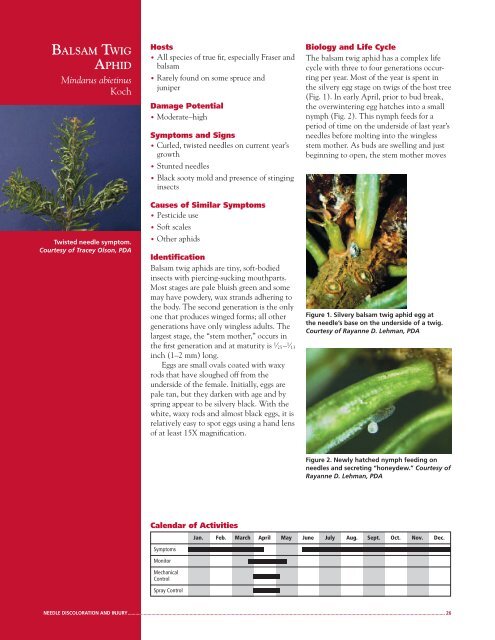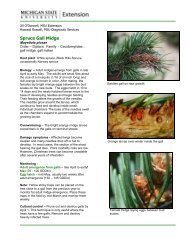Integrated Pest Management for Christmas Tree Production: A ...
Integrated Pest Management for Christmas Tree Production: A ...
Integrated Pest Management for Christmas Tree Production: A ...
Create successful ePaper yourself
Turn your PDF publications into a flip-book with our unique Google optimized e-Paper software.
BALSAM TWIG<br />
APHID<br />
Mindarus abietinus<br />
Koch<br />
Twisted needle symptom.<br />
Courtesy of Tracey Olson, PDA<br />
Hosts<br />
• All species of true fi r, especially Fraser and<br />
balsam<br />
• Rarely found on some spruce and<br />
juniper<br />
Damage Potential<br />
• Moderate–high<br />
Symptoms and Signs<br />
• Curled, twisted needles on current year’s<br />
growth<br />
• Stunted needles<br />
• Black sooty mold and presence of stinging<br />
insects<br />
Causes of Similar Symptoms<br />
• <strong>Pest</strong>icide use<br />
• Soft scales<br />
• Other aphids<br />
Identifi cation<br />
Balsam twig aphids are tiny, soft-bodied<br />
insects with piercing-sucking mouthparts.<br />
Most stages are pale bluish green and some<br />
may have powdery, wax strands adhering to<br />
the body. The second generation is the only<br />
one that produces winged <strong>for</strong>ms; all other<br />
generations have only wingless adults. The<br />
largest stage, the “stem mother,” occurs in<br />
the fi rst generation and at maturity is 1 ⁄25– 1 ⁄13<br />
inch (1–2 mm) long.<br />
Eggs are small ovals coated with waxy<br />
rods that have sloughed off from the<br />
underside of the female. Initially, eggs are<br />
pale tan, but they darken with age and by<br />
spring appear to be silvery black. With the<br />
white, waxy rods and almost black eggs, it is<br />
relatively easy to spot eggs using a hand lens<br />
of at least 15X magnifi cation.<br />
Calendar of Activities<br />
Symptoms<br />
Monitor<br />
Mechanical<br />
Control<br />
Spray Control<br />
Biology and Life Cycle<br />
The balsam twig aphid has a complex life<br />
cycle with three to four generations occurring<br />
per year. Most of the year is spent in<br />
the silvery egg stage on twigs of the host tree<br />
(Fig. 1). In early April, prior to bud break,<br />
the overwintering egg hatches into a small<br />
nymph (Fig. 2). This nymph feeds <strong>for</strong> a<br />
period of time on the underside of last year’s<br />
needles be<strong>for</strong>e molting into the wingless<br />
stem mother. As buds are swelling and just<br />
beginning to open, the stem mother moves<br />
Figure 1. Silvery balsam twig aphid egg at<br />
the needle’s base on the underside of a twig.<br />
Courtesy of Rayanne D. Lehman, PDA<br />
Figure 2. Newly hatched nymph feeding on<br />
needles and secreting “honeydew.” Courtesy of<br />
Rayanne D. Lehman, PDA<br />
Jan. Feb. March April May June July Aug. Sept. Oct. Nov. Dec.<br />
NEEDLE DISCOLORATION AND INJURY .......... ................................................................................................................................................................................................................................................ 26





